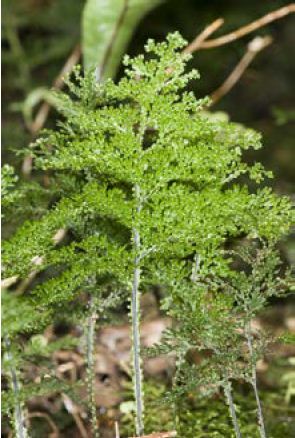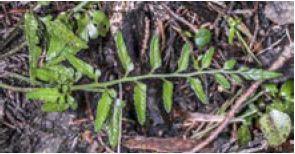Trip Report – 4 August 2012: Three Karori reserves
 |
| Hymenophyllum flexuosum. Photo: Jeremy Rolfe. |
Fine, calm weather was a bonus in mid-winter and encouraged a good turnout, including four Zealandia / Karori Sanctuary guides. The itinerary was carefully planned as an urban cross-country traverse, instead of a more usual circular route, so participants were able to reach the start by public transport, and to finish similarly. Travelling west-to-east, we climbed Burrows Avenue Reserve’s zig-zag track, connected with the Wright Hill summit track at c. 300m. a.s.l., descended it to the weedy “roller-coaster” track along the Karori Sanctuary fence, then descended Birdwood Reserve’s zig-zag track to Waiapu Road. Right from the start, just inside Burrows Avenue Reserve, there was plenty to observe, and we admired several huge fuchsias,
Fuchsia excorticata, ancient trees with dense clusters of dead, vertical, epicormic shoots sprouting from their trunks. These shoots are what remain of the trees’ desperate efforts a few years ago, to produce fresh green leaves to replace the possum-browsed foliage of their crowns. Fortunately Greater Wellington Regional Council’s comprehensive possum control over the years has ensured the recovery of the crowns, thus enabling photosynthesis to resume. As a result, the epicormic shoots having become redundant, have died off, a natural ecological process. With twenty pairs of eyes scanning the tracksides, additions were frequent and some long discussions were held en route. Part way up we saw the huge old
Hoheria sexstylosa pictured in the last newsletter, and shortly, a shaded rock wall where three uncommon fern species grow together: the endemic
Loxogramme dictyopteris (=
Anarthropteris lanceolata), with its narrowly elliptic, drooping fronds; the endemic “crinkle fern”
Hymenophyllum flexuosum, and a thick pelt of
Trichomanes endlicherianum, the smallest species of the genus.
Later Leon was surprised to find
Polystichum neozealandicum x
P. silvaticum, an addition to the list. After lunch, we climbed toward Wright Hill adding several species including
Dicksonia fibrosa, kamahi,
Earina mucronata, and
Coprosma foetidissima. After walking along the weedy ‘roller-coaster’ track outside Zealandia’s fence, we descended Birdwood Reserve, another local Wellington ecological gem. Here we saw a large
Griselinia lucida near the adit of the abandoned Golden Crown gold-mine.
It was then after 4 p.m., and because we had taken our time to study and appreciate the significant botanical values of these three Karori reserves, we had diddled ourselves out of the promised afternoon tea at Zealandia’s Rata Cafe.
 |
| Asplenium lyallii. Photo: Jeremy Rolfe. |
Participants : Bev Abbott, Gavin Dench, Ann Graeme, Anthony Hill, Bryan Halliday, Chris Horne (co-leader), David McCrone, Barbara Mitcalfe (co-leader / scribe), Chris Moore, Mick Parsons, Leon Perrie, Hugh Robertson, Lea Robertson, Jo Schofield, Lara Shepherd, Sunita Singh, Des Smith, Wynn Udall, Juli Usmar, Irene Walshe.
Postscript
The following weekend, Barbara Mitcalfe, Chris Horne, and Jeremy Rolfe botanised the Salvation Track in Wright Hill Reserve. We found several more specimens of
Hoheria sexstylosa,
Loxogramme dictyopteris, and also investigate a population of
Asplenium lyallii that had been previously reported by Lara Shepherd and Leon Perrie.

 Site Index
Site Index







 Site Index
Site Index





